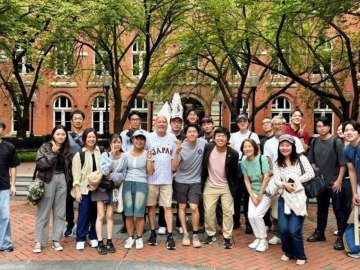Fumiki Amemiya, Full-time Consultant, Waseda University History Museum
As the expression "passing the entrance exam for a prestigious university" suggests, there is a certain amount of admiration for universities and university students in Japanese society. Waseda University is perhaps one of the universities that is strongly admired by not only students taking entrance exams, but many other people as well.
However, if we look at university students in prewar Japanese society, we can see that they formed a culture that is almost unimaginable today.
Before the war, university students were easily identifiable by appearance. At that time, universities were overwhelmingly made up of male students, who wore uniforms with stand-up collars (gakuran) and caps (mortarboards). In particular, the design of the motarboards made it possible to identify which university a student was from.

A photograph taken around 1901 of Shigenobu Okuma and his wife (front row, center) with students. The students are seen wearing early mortarboard caps without brims.
University students in those days flaunted their university status in society, and they had a great deal of authority. For example, when students from Tokyo Imperial University traveled to Izu in the 1910s, they were introduced to the best room in a prestigious inn by a prominent local person, but a married couple who were prominent fishermen and served as representatives and stayed there at the same time did not complain when they were shown to a lower-class room. Even older, more prominent people did not feel uncomfortable when younger people were using the best rooms; this was the authority that university students had before the war.

A photograph taken in the mid-1920s of educational scholar Hanjiro Nakajima (graduated from the Department of Literature in 1894) and philosopher Odo Tanaka (enrolled around 1885) with students. The students are seen wearing brimmed caps and uniforms.
Waseda University students also held a certain degree of authority, but what was distinctive about them was that they maintained a certain element of what could be called a counterculture to the state.
In prewar Japan, the state took the lead in forming a government-sponsored education system with the Imperial University at the apex. Meanwhile, Waseda University (originally Tokyo Senmon Gakko), coupled with the situation of Okuma Shigenobu being expelled from the government, endured and resisted many government pressures, and developed. In the process, political economy, which was unfamiliar at the time of its founding, was established as an academic field, and School of Humanities and Social Sciences (then the Department of Letters), led by Tsubouchi Shoyo, became synonymous with Waseda.
According to Alumnus and former Prime Minister Ishibashi Tanzan (1907 Literature Department graduate), even after graduation Waseda students found it difficult to succeed in the government, education, and business worlds where graduates of the Imperial University held influence, but they did not give in and continued to develop their activities in the newspaper, literary, and art worlds. This is another characteristic of Waseda graduates, and they have had a great impact on society.
However, Ishibashi is critical of the fact that while Imperial University students preferred to wear mortarboards even if they did not wear uniforms, some Waseda students preferred to wear fedoras, which were thought to have become popular at Waseda earlier than the general public, rather than mortarboards. However, this is probably only pointing out one aspect of Waseda students.

A photo of Nakajima Hanjiro and students taken in the 1920s. In addition to the mortarboard caps, some of the students are wearing fedoras.
Author Yagi Yoshinori (1938 Graduate of School of Humanities and Social Sciences), who spent his time as a student at Waseda University in the 1930s, recalls that he had to wear only one uniform to attend classes. He rarely wore a mortarboard cap to ensure that it was of a quality that could be pawned, but outside of school he would wear a kasuri kimono with a black fedora and carry a walking stick, which he says was established as the fashion style of Waseda School of Humanities and Social Sciences. The fact that he found a way to express the uniqueness of his chosen university without relying on a mortarboard cap can be evaluated as being in line with the culture of Waseda students, who did not approve of conforming to the times.
[References]
Hayashi Kaname, "Damn You, That Person, This Person" (Hosei University Press, 1970)
Ishibashi Tanzan, The Complete Works of Ishibashi Tanzan, Volume 15 (Toyo Keizai Shinposha, 1972)
Waseda Gakuho No. 644, Yoshinori Yagi, "School Caps and Walking Sticks -- My Student Days --" (Waseda University Waseda University Alumni Association, October 1954)
Waseda University 150-Year History Editorial Committee (ed.), Volume 1 of the Waseda University 150-Year History (Waseda University, 2022)






![[Save version] Map of the four main campuses](https://www.waseda.jp/inst/weekly/assets/uploads/2025/09/17cb2975123fc5103172ef60bd98608d-610x458.jpg)

